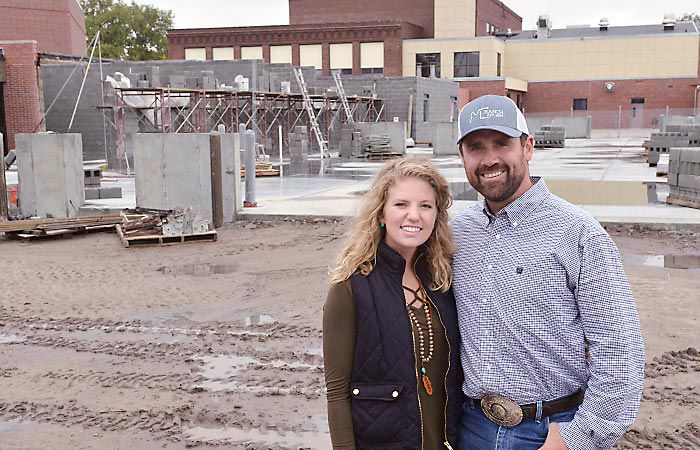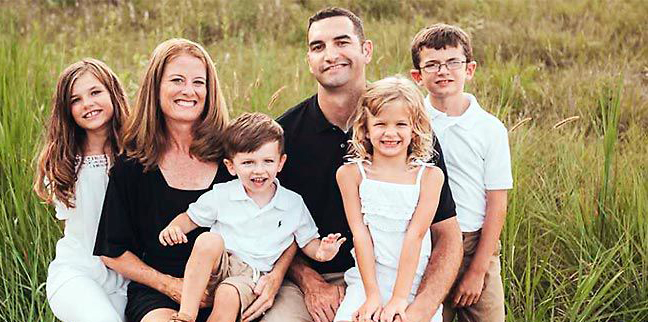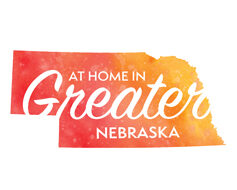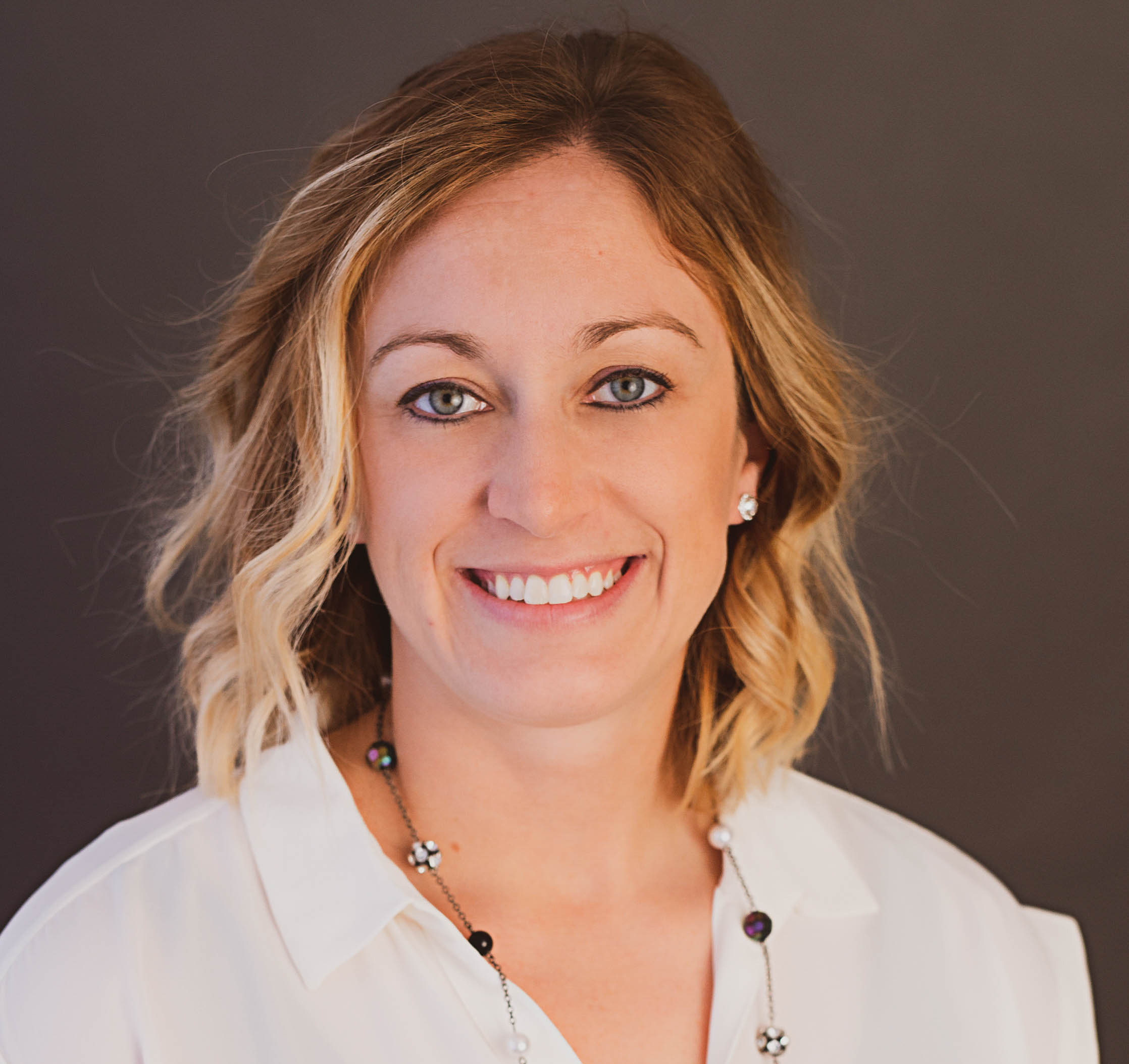 By EMILY CASE | Norfolk Daily News
By EMILY CASE | Norfolk Daily News
Mark and Haley Miles love showing Ainsworth to the uninitiated.
They’ll invite people out for a weekend of tubing and let them drink water at the base of a windmill, straight out of the ground.
“We think this area is kind of a gem,” Mark Miles said.
He’s always been connected to the land, as a fifth-generation Ainsworth farmer and rancher whose family has been in Brown County since 1887.
“The thing I love about this area is the combination of the grasslands (with) the end of the corn belt,” he said. “Where the pastures and farm ground came together, that’s always attracted me.”
Haley Miles has been passionate about her community, too, but she wasn’t sure if she’d ever have the opportunity to move back.
“I always wanted to move back eventually but … why would anyone want to move to Ainsworth (with me)?” she said. “It’s a huge blessing he’s from here and we both care about the same place because I thought that wouldn’t happen for me.”
Now, after both living away from Ainsworth, Mark and Haley Miles have returned to a community that has become vibrant with community involvement. It’s the place they want their kids to grow up when they start a family.
“There’s just exciting things going on that make us excited to be here and hopefully raise a family here, too,” she said.
* * *
Ainsworth is a place you have to want to live, Mark Miles said. “You’re far enough away from the interstate or midsize cities that people don’t just throw a dart at a map,” he said.
The closest Walmart is over two hours away, and it’s over four hours to a major airport. The city, however, does have a Shopko Hometown, two local grocery stores, a hospital and a high school.
With a population of 1,635 as of 2016, it’s the largest city and county seat in Brown County, although the community also serves about 1,500 people who live near the area, he said.
The population has been in an overall decline from a census total of 2,256 in 1980. But Kristin Olson, executive director of North Central Development Center (NCDC), said she’s seen more young people moving back to the area within the past 10 years.
“We’ve had a lot of young couples move back to the area; that’s impressive, that speaks for itself,” she said. “With that, I think there’s new energy starting to flow through the community, too.”
Olson talks passionately about countless programs that community members helped start. One of her stories involves Haley Miles, who worked with the NCDC office as a high schooler through a program that allows students to shadow or work for local businesses.
While in high school, Haley helped start a local soccer program through a group called the Youth Community Development Force. When they discovered that a lot of students were leaving town for soccer practice, they wanted to bring a program to Ainsworth.
Now, the community soccer program has been running for more than 10 years, serves about 120 athletes per year and has been turned over to the City of Ainsworth, Olson said. But what’s most impressive is that the entire program was thought up and carried out by students.
“The cool part is the high school kids put it together: They raised money for the balls, nets, goals,” she said. “They actually recruited their peers to come in and coach. Our coaches are all high school students. To this day, they still are.”
The soccer program is one example of many illustrating youth involvement in Ainsworth, Olson said. For Haley, this involvement helped instill in her a sense of responsibility in serving her community.
“The (community leaders) let me be involved, and they listened to their youth,” she said. “I felt like I had a lot of ownership in my community growing up.”
Now, Haley is involved in a variety of local organizations. She’s on a steering committee that oversees six committees in town that address important issues like housing, business and infrastructure. She also started an FFA alumni organization and is planning to start a young professionals group for high schoolers.
Haley and Mark also lead youth groups at their church, as well as Fellowship of Christian Athletes. Plus, she’s undertaking the 18-month ag-based Nebraska Leadership Action Education Development (LEAD) program at University of Nebraska-Lincoln, which he completed last year.
Then, there was wedding planning: They got married in June.
They have juggled these commitments while running his family’s ranch and farm business, which means long hours out in the field, especially during planting season.
“We did most of our wedding planning in the tractor,” she said.
Both know the farming lifestyle is a lot of work, but they see tending crops and cattle as teamwork and quality time.
“On Saturdays (we might) saddle up on horseback and round up cattle from pasture,” he said. “We might have a friend come help us. To us, that’s spending time together and community. Other people might look at it as work.”
That kind of mindset — steadfast cultivation and finding fulfillment in working together — seems rooted in community values, where committees often work with the long game in mind, Olson said. The results of many projects won’t be seen for years.
“As long as we’re moving forward, we’re making progress,” she said. “Sometimes you don’t see it in the first year. Some things (from 10 years ago) are just now coming to fruition.”
Olson said the challenges Ainsworth faces are the same as other rural Nebraska towns, such as housing and workforce recruitment. But she’s proud of the self-starting attitude community members have shown in facing these issues.
“It’s more the way each community has a choice, how they’re going to address those problems,” she said. “We’re not unique by any means, but the way we’re unique is in dealing with those is our committees and individuals who have stepped up to the plate.”
Central to these community players are young people, most of whom are “boomerangs” — people who grew up in Ainsworth, lived elsewhere and moved back.
Mark and Haley both lived in other places. He worked in Omaha for five years as an ag lender, and she moved to eight different places before coming back.
They both see their classmates returning to town and said a factor for those who haven’t come back isn’t lack of desire but a lack of opportunity. NCDC is addressing this with a referral program to match job candidates with the right position in town.
Establishing personal connections is how Olson is addressing recruitment, because people who are familiar with Ainsworth or rural Nebraska are more likely to stay, she said. The success Olson has seen with transplants comes from having some sort of connection to the area.
To introduce new people to the region, Mark started an outreach program in 2016. He collaborates with the Chicago High School of Agricultural Sciences and LEAD program to provide a tour of Ainsworth ag businesses and UNL ag program. So far, it has inspired two students to attend school in Nebraska.
He sees this kind of mentorship, especially the time he spends with FCA and youth group students, as planting seeds for future involvement, no matter where they end up.
But Mark said he hopes they eventually find their way to Ainsworth — like he did.



